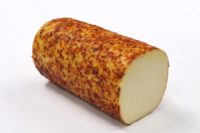Flavored cheeses have become increasingly popular in recent years. In 2014 alone, Americans bought almost a quarter-billion pounds of flavored cheese (246 million pounds). Flavored cheeses are a $1.5 billion market, according to the Wisconsin Milk Marketing Board.
Through the first five months of 2015, the flavored cheese market continues to expand, with 4.5% growth compared to the same period a year ago in terms of pounds, and 8.3% growth in terms of dollars. This far outpaces the 0.5% growth in pounds of unflavored cheeses. For example, Chipotle flavoring alone grew by 190% in 2013.
The top three flavors used in cheese are jalapeno, smoke and taco. While American consumers are increasingly looking for bolder and spicier flavors, sweet, savory, herb and nut flavors are also important trends. Based on this type of data it’s not surprising to see so many cheesemakers experimenting with flavor.
3 challenges in working with flavors
While this broad range of cheese flavors and ingredients benefits consumers and industry sales, these flavor trends also bring with them potential challenges that many cheesemakers may not anticipate including contamination issues, allergen issues and flavor profile challenges.
Perhaps the first issue that a cheesemaker encounters when attempting to add flavor to cheese is the challenge of selecting and then achieving a desirable flavor. For most ingredients and flavors, cheesemakers have the options of adding the flavor to the milk, mixing it in with curd, rubbing the ingredient on the outside of the cheese, soaking the cheese or injecting the flavor directly into the product.
The end flavor profile will be dependent on the type of cheese and the method used. As a general rule, hard cheeses absorb flavor best when it is rubbed on the outside or when the cheese is soaked. Soft cheeses do well when the flavor is added to the curd.
Whichever option you choose, keep in mind how that method may affect the end product. For example, if you are making an aged cheese, you will want to consider how the flavor will change over time and whether you want the flavor to be subtle or strong. Don’t be afraid to take the time to experiment with flavors and textures.
Green tea, kimchee flavors
An excellent example of flavor innovation that may result is the Blue Marble Jack cheese from Nasonville Dairy, Marshfield, Wis. This marble jack contains the visual and flavor attributes of a blue cheese but is sliceable. Green tea, kimchee, Hispanic and Mexican-style spices and other bold and internationally diverse flavors are also worth exploring.
Another consideration for cheesemakers when experimenting with flavor is the potential for contamination issues. Herbs, spices, fruit and other such ingredients can harbor a great deal of bacteria or yeasts/molds that may negatively affect your cheese. The best way to avoid such issues is to use ingredients that have been monitored by your supplier and come with a specification sheet that guarantees their low microbe load.
Mind the pH and moisture
Additionally, adding these components into your cheese can also shift the pH and/or moisture, which can affect the end product as well as the safety of the cheese. In order to avoid this pitfall, it is important to carefully formulate your cheese and make adjustments along the way to keep the pH and moisture at a safe and desirable level for the specific cheese you are making. Added sweeteners may also be fermented by the starter bacteria and can cause off-flavor and shelf-life issues. Sweeteners may also lose their flavor intensity over time. To avoid these issues, it’s best to experiment with sweeteners in your make procedure and see which one nets the best result.
In conclusion, with a little extra research and experimentation, you can avoid many of the potential issues that may arise from the addition of new flavors or ingredients to your cheeses. By taking the time to experiment with flavor combinations that complement your current cheese varieties, you now have the opportunity to create new, value-added and exciting products to meet consumers’ increasing demand for bolder flavor profiles.



